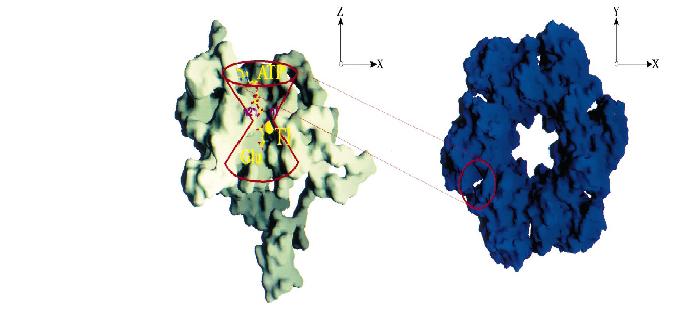User:Grace Natalie
From Proteopedia
(Difference between revisions)
| Line 5: | Line 5: | ||
<font size=2>Glutamine synthetase (GS) catalyzes the ATP-dependent condensation of ammonia and | <font size=2>Glutamine synthetase (GS) catalyzes the ATP-dependent condensation of ammonia and | ||
glutamate to yield glutamine, ADP, and inorganic phosphate in the presence of divalent cations | glutamate to yield glutamine, ADP, and inorganic phosphate in the presence of divalent cations | ||
| - | <applet load='1lgr' size='350' color='white' frame='true' align='right' caption='Glutamine Synthetase from Salmonella typhimurium'/> | ||
<ref name="Liaw">Liaw, S-H, et.al.,Discovery of the ammonium substrate site on glutamine synthetase, a third cation binding site Protein Sci. 1995 4: 2358-2365</ref> . | <ref name="Liaw">Liaw, S-H, et.al.,Discovery of the ammonium substrate site on glutamine synthetase, a third cation binding site Protein Sci. 1995 4: 2358-2365</ref> . | ||
The reaction occurs in two steps with γ-glutamyl phosphate as an intermediate and is used by | The reaction occurs in two steps with γ-glutamyl phosphate as an intermediate and is used by | ||
| Line 15: | Line 14: | ||
<center><font size=2>Glutamate + NH<SUB>4</SUB><SUP>+</SUP> + ATP --> glutamine + ADP + P<SUB>i</SUB></font></center> | <center><font size=2>Glutamate + NH<SUB>4</SUB><SUP>+</SUP> + ATP --> glutamine + ADP + P<SUB>i</SUB></font></center> | ||
<br> | <br> | ||
| + | <applet load='1lgr' size='350' color='white' frame='true' align='right' caption='Glutamine Synthetase from Salmonella typhimurium'> | ||
<font size=4 face ="Arial">Overall Mechanism</font> | <font size=4 face ="Arial">Overall Mechanism</font> | ||
<br> | <br> | ||
Revision as of 04:16, 22 December 2008
Background
Glutamine synthetase (GS) catalyzes the ATP-dependent condensation of ammonia and
glutamate to yield glutamine, ADP, and inorganic phosphate in the presence of divalent cations
[1] .
The reaction occurs in two steps with γ-glutamyl phosphate as an intermediate and is used by
bacteria to introduce reduced nitrogen into cellular metabolism. GS is a dodecamer formed from
two face-to-face hexameric rings of subunits, with 12 active sites formed between monomers
[2] .
| |||||||||||

